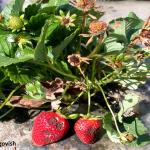Strawberry IPM- Anthracnose
Anthracnose is a general term for diseases caused by species of the fungus Colletotrichum. In the Northeast, anthracnose of strawberries is caused by Colletotrichum acutatum, which can infect all parts of the plant. C. acutatum has become increasingly troublesome since it was first identified in the US in 1986. Fruit rot is of particular concern as the fruit is rendered unmarketable. C. fragariae and C. gloeosporioides are more commonly associated with a lethal crown rot, but these species are more common in warmer climates. C. acutatum is endemic in the Northeast, but may also be brought in on infected transplants.
Signs and Symptoms
All three Colletotrichum species associated with strawberry anthracnose can cause leaf spots and/or dark lesions on petioles and stolons, crown infections, flower blight, and fruit rot. Leaf spots caused by C. acutatum are brown to black and often more numerous along leaf tips and margins. The spots differ somewhat from the randomly distributed gray to black spots caused by C. fragariae or C. gloeosporioides. Petioles and stolons may become girdled, causing death of leaves and daughter plants. Open flowers are more susceptible to blight than closed buds. Anthracnose can also affect fruit at any stage of development from flowering to harvest. On fruit, symptoms may begin as small light colored or water-soaked lesions a few millimeters in diameter. These lesions grow progressively larger and darker as they mature and end as sunken black spots. After a few days, salmon-colored masses of conidia appear in the lesions. Fruit may eventually become shrunken and mummified. Crowns infected by Colletotrichum species will be firm and reddish-brown inside. The discoloration may be uniform or show light and dark brown streaks. C. acutatum is capable of causing crown infections, but plants usually survive, remain stunted, and produce few berries. Crown infections may occur in the nursery, but can remain latent until well after planting. C. acutatum can also cause root lesions.
Life Cycle
C. acutatum survives winter in plant debris, particularly mummified fruit. Primary inoculum is produced in spring. The optimum temperature for disease development is about 27°C (80°F); however, the fungus can infect fruit at lower temperatures, and spring infections may remain latent until warm, wet conditions induce disease development. Lesions produce conidia that may continue the infection process throughout the growing season. The time from infection to first sporulation is 7-11 days at 5°C and 2-3 days at 25°C. The fungus can produce conidia at temperatures from 5-35°C, though production is most abundant at 22-26°C. An adequate period of surface wetness is also required for infection. At 25-30°C, infection occurs in less than 24 hours, but at lower temperatures, a longer wetness period is required. Spores are most often spread by splashing rain, but they may also be transported by insects, animals, and farm workers. Although C. acutatum has a wide host range that includes many fruit, vegetable, and weed species, research suggests that strains of C. acutatum that are pathogenic on strawberries are relatively host specific.
Management
Cultural
Start with certified disease-free plants whenever possible, or use anthracnose resistant cultivars such as ‘Pelican’ and ‘Sweet Charlie’. In annual systems, anthracnose is most common on raised beds with black plastic mulch. Minimize spore dispersal by avoiding overhead irrigation and by using straw mulch instead of black plastic on strawberry beds and in between rows. Increase plant spacing to improve air circulation. Remove infected plant material. Perennial cropping systems should be maintained for no more than five years as inoculum of C. acutatum can build up in the soil over time. Control weeds, especially wild strawberry if present. Scouting is important, although the disease is likely to be well established by the time symptoms occur. Farm workers should enter infected fields last to avoid carrying spores to uninfected areas. Do not work in infected fields when foliage is wet. Experiments have shown that plants grown in soil with high nitrogen levels, particularly from ammonium sources, are more susceptible to anthracnose than plants grown in soils with lower nitrogen levels or with high levels of calcium nitrate.
Chemical
Both organic and conventional fungicides are more effective when applied preventatively. OMRI approved products include Cease (Bacillus subtilis QST 713), which has been shown to provide some protection from fruit rot. Copper and sulfur based compounds are also available; however, neither is very effective for anthracnose control and both can be phytotoxic under certain conditions. Conventional fungicide choices include captan, pyraclostrobin, azoxystrobin, cyprodinil and fludioxonil. Check product labels for appropriate timing and application rates. Always follow the label instructions- the label is the law.
Forecasting: The Strawberry Advisory System (SAS) monitors weather conditions and reports on the risk of anthracnose and Botrytis. https://agroclimate.org/tools/strawberry/
References
Louws, F., Ridge, G., and Harrison, G. 2014. Anthracnose Fruit Rot of Strawberry. https://content.ces.ncsu.edu/anthracnose-fruit-rot-of-strawberry
Smith, B. 2008. Epidemiology and pathology of strawberry anthracnose: a North American perspective. HortScience 43: 69-73.
Turechek, W. Strawberry Anthracnose Control. https://hdl.handle.net/1813/42722

